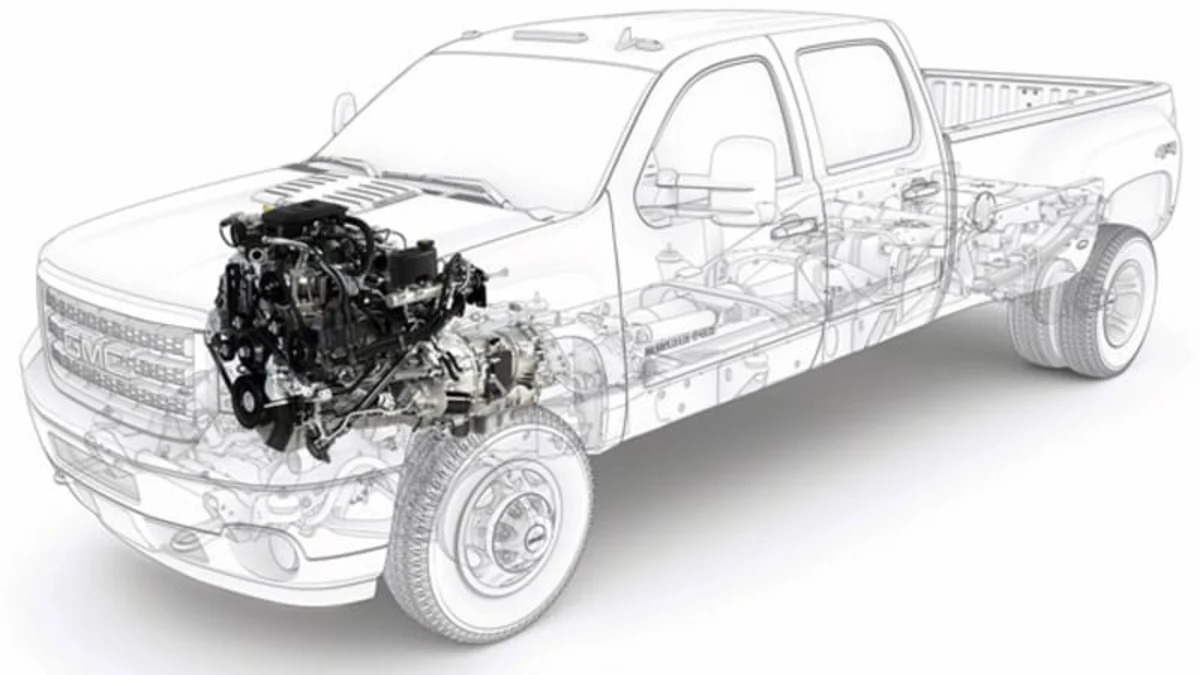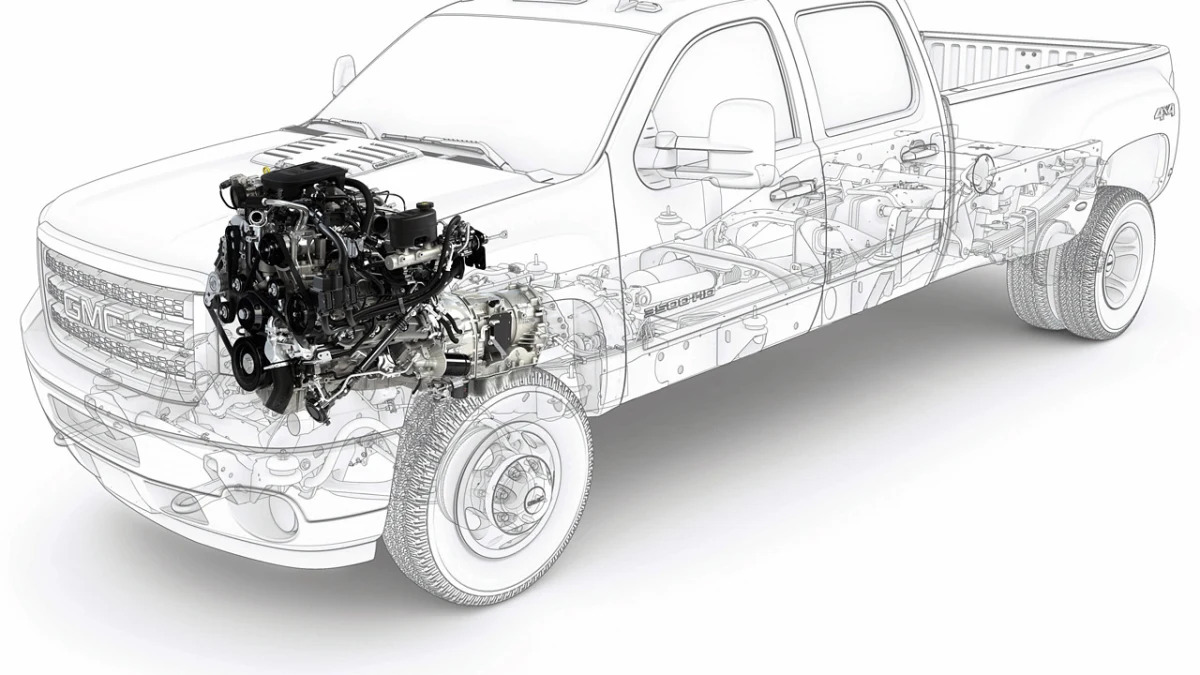2011 GM HD Truck New Technology – Click above for high-res image gallery
At first glance, the 2011 Chevrolet Silverado and GMC Sierra heavy-duty pickup trucks don't appear to have changed much compared to their 2010 counterparts. But don't let their familiar faces fool you, because virtually all of the greasy bits have been substantially upgraded or replaced entirely. Like the competitive heavy-duty trucks from Ford and Dodge, General Motors offers its trucks in a huge array of configurations with varying passenger, payload and towing capacities and an array of gasoline and diesel engines.
We drove seven different variants over two days in the Allegheny mountains of western Maryland along with the latest models from Dodge and Ford for comparison's sake. While the sales volume in the heavy-duty truck segment is smaller than it was at its peak a few years ago, it is still hugely profitable and comprises about 25 to 30 percent of all pickup sales. Follow the jump to learn more about what General Motors' truck engineering team has done to help ensure those dollars keep rolling in.
Live photos by Sam Abuelsamid / Copyright ©2010 Weblogs, Inc.
As GM lurched toward bankruptcy last year, it culled its Saturn, Hummer and Pontiac brands, and sold Saab. Along with Buick, many armchair quarterbacks of the industry wondered aloud why GMC was preserved since its lineup consists of nothing more than badge-engineered Chevy trucks – it was thought that GMC could be shut down and Chevrolet could pick up the slack. However, when company executives sat down with the Obama administration's auto industry task force to review the business plan, one look at GMC's numbers ensured its survival.
Contrary to what logic might presume, GMC and Chevrolet truck buyers aren't really one and the same. GMC buyers are generally younger, better educated and more affluent. Perhaps best of all, those opting for Sierras are more likely to pick higher trim levels, crew cabs, diesels and add accessories – all of which do wonderful things for profit margins. Unlike Ford's Mercury division, which saw its sales shrivel in the past decade, GMC is thriving and the future could be even brighter as new models follow the path of the Acadia and Terrain with more unique styling. For now, however, except for the Sierra Denali, GMC and Chevy pickups are essentially the same. Thankfully, that's no bad thing as you'll soon see.

The Silverado and Sierra HD pickups are available in so-called 3/4-ton 2500 models and one-ton 3500 models. As you might guess after a quick perusal of the spec sheet, the 3/4- and one-ton designations are little more than a carryover nomenclature from bygone days when they were limited to those payloads. As all trucks have become more capable, even the light-duty 1500 can carry over 1,500 pounds. Depending on the configuration, 3/4-ton 2500 models now accommodate up to 4,192 pounds and the one-ton 3500 can haul 6,635 pounds. Not coincidentally, both of those figures are ever so slightly better than Ford's corresponding F-250 and F-350 Super Duty models.
While Dodge has applied the styling of the latest light-duty Ram to its new HD trucks and Ford has fitted its F-Series with the boldest looking grille we've seen yet, GM has taken a more conservative approach. The front bumpers on both trucks are slightly reshaped, with bigger air intakes below the grille and the Sierra gets a perforated three-bar look similar to the Terrain CUV. Other than that, the sheetmetal carries over. As before, these HD pickups are available in regular, extended and crew-cab styles with 6.5- or eight-foot cargo boxes. Both the 2500 and 3500 are available with the single-wheel rear axle while the 3500 can also be outfitted with the dual-wheel rear axle. Most of these combinations are also available with either a 6.0-liter Vortec gasoline V8 (below, left) or the 6.6-liter Duramax diesel V8 (below, right) and rear– or four-wheel drive.


Cab choices have also been carried over from the 2010 models with two different configurations available. Lower-end work truck models have a decidedly cheap looking instrument panel with hard plastics in a couple of different shades of gray. The matte finish may be dull and uninteresting, but this is a work truck first and foremost, and the space and ergonomics don't offer anything to complain about. Audio and climate controls on the center panel are pushed up between the vents, leaving a clear area under the dash for the legs of a center passenger. The most basic variants come with manual crank windows and a 60/40 split front bench seat that allows the driver some independent adjustability.
High-end models with the two-seat first row layout feature a full-length center console and the same dashboard that we're used to in GM's Tahoe and Yukon SUVs. The console offers plenty of storage space for log books, phones, cameras and whatever else a crew boss might need to stow – including a laptop computer. General Motors has no current plans to offer an equivalent to Ford's "Work Solutions" package, arguing that while the functionality it offers is indeed very useful, it's also very expensive.




Instead, like many other GM vehicles, the HD trucks now offered with Autonet WiFi. Autonet provides a small wireless router with a built-in 3G mobile broadband modem. As soon as the truck is started, the router fires up, connects automatically and provides internet access to anyone within about 50 feet of the vehicle. With Autonet and OnStar's built-in GPS receiver, commercial truck users can use their existing laptops or netbooks to do much of what is already possible with Work Solutions. The biggest missing function is the tool tracking capability, but Vehicle Line Executive Rick Spina told us that when GM spoke to truck owners, they were told that the number of tools lost or left behind on-site typically adds up to far less than the cost of Tool-Link.
Peel away the bodywork and almost everything else is new, starting with the frame that forms the foundation of these beasts. The two main longitudinal rails are still hydro-formed, but they are now fully boxed from bumper to bumper. Only the larger chassis cabs retain a C-channel rear section to facilitate mounting whatever they end up carrying. A stiff frame is critical to durability and improving ride and handling, and in the not so distant past it was common to see the bed and cab of a pickup truck quivering independently over rough pavement. This new chassis and re-worked suspension, however, has greatly reduced that tendency and contributes to improved payload and towing capability.

At the front corners, an independent control-arm suspension setup is retained, and it's a unique setup in this segment. The control arms are now wider than before to foster better control and isolation. At the rear axle, the leaf springs have gone from 2.5 to three inches in width. According to GM engineers, the wider springs reduce the internal stresses, thereby improving durability and load carrying capacity. The leaf-spring-axle configuration is now asymmetrical for the first time, a move that cuts down on axle windup under acceleration and braking, neatly improving handling at the same time.
Hanging off the ends of the suspension members are bigger brakes than have ever been fitted to a GM truck. The rotors have grown from 12.8 to 14 inches in diameter at both axles and the swept area of the pads has increased by 13 percent. As recently as the late 1990s, applying the brakes in a fully laden GM truck could be a nerve-racking experience. Back then, pedal feel was similar to stomping on a wet sponge, and your work boot might move through one-third to one-half of the pedal travel before any significant amount of retardation occurred. The new calipers and their resultant brake feel are much stiffer than before, eliminating much of that marshmallowy feel. The net-net is confidence inspiring stopping power, especially when the truck is loaded.


For 2011, all single-rear wheel 2500 and 3500 models also receive full electronic stability control with trailer sway control. The system detects if the trailer is starting to oscillate back and forth as it would before washing away completely. If the sensors detect eminent calamity, the system alternately applies the truck's brakes from side-to-side until everything settles down again.
The 364-horsepower 6.0-liter Vortec V8 and 6L90 six-speed automatic are carryover from 2010, but they remain among the best gasoline truck engines available. However, for those who really need serious hauling capability, the optional 6.6-liter Duramax diesel V8 and Allison 1000 six-speed automatic transmission are the only way to go. Unlike the Blue Oval's Scorpion V8, the Duramax is not all-new, but it is heavily revised. Like other modern diesels, it now has a high-pressure common-rail injection system with piezoelectric injectors that can execute multiple pulses per ignition cycle. This allows the fuel delivery to be more precisely metered and spread out over a longer time so that combustion temperatures remain under control. Lower combustion temperatures help reduce NOx production so that the Duramax can meet the 2010 emissions standards.
The engine changes alone are not enough to make the Duramax clean. Like the Super Dutys and all of the six-cylinder German diesels in the States, GM has also incorporated a urea injection system to clean up whatever residual NOx is produced. The heated, 5.3-gallon urea tank is mounted on the frame rail adjacent to the oxidation catalyst and needs to be refilled about every 5,000 miles along with oil changes. In addition to running more cleanly, the Duramax also has improved fuel economy by about 11 percent, more power and torque and is much quieter than ever before. Heavy-duty trucks don't have to carry EPA window stickers, but according to GM's Spina, the 3500 diesel achieves a combined rating of about 17 miles per gallon.



All recent heavy-duty trucks have had a tow-haul mode that allows the driver to lightly apply the brake pedal for a couple of seconds and trigger automatic transmission downshifts when on a downhill grade. The diesel trucks also add exhaust gas braking that typically uses a bypass valve to increase the exhaust back pressure in the engine, forcing it to slow down. When carrying a heavy load or towing, this can help reduce the workload on the brakes dramatically. For its 2011 trucks, GM has taken this technology a significant step further. The existing exhaust gas braking systems are basically just on-off controllers, but with the new Duramax, the system monitors vehicle speed when you set the cruise control, and in addition to maintaining speed when going uphill, it uses the variable geometry vanes in the turbocharger to adjust the backpressure just enough to hold a constant speed when going downhill. Even without using the cruise control, just tapping the brake pedal for a few seconds will trigger exhaust braking and hold the speed on a grade without using the binders.
All of which is a long way of saying there's a lot of fancy technology at work underneath what most people think of as just simplistic beasts of burden. As it's not uncommon for the people who drive these trucks to accumulate 100,000 hard miles each year, it's particularly important to understand how well the drive. Stay tuned – we'll have our full driving impressions later today around noon.
Photos Copyright ©2010 Sam Abuelsamid / Weblogs, Inc.
Our travel and lodging for this media event was provided by the manufacturer



Sign in to post
Please sign in to leave a comment.
Continue